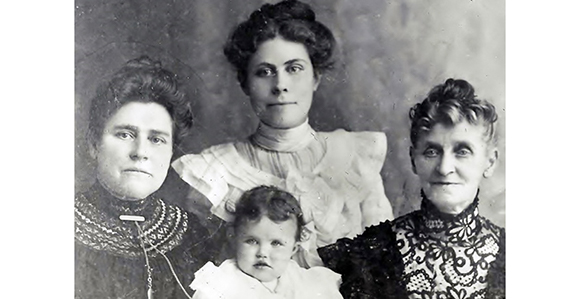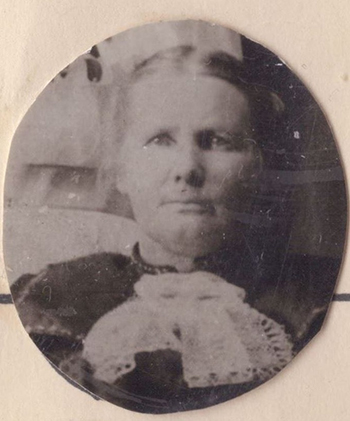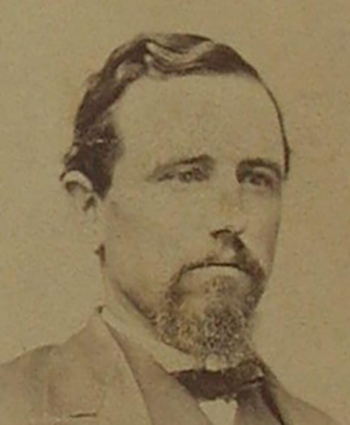Church History Tells Stories of Extraordinary Pioneer Youth
Contributed By Sarah Harris, Church News staff writer

Emily Hill, right, is pictured in a four-generation photo. Photo courtesy of FamilySearch.org.
“The flesh certainly was weak, but the spirit was willing. I set down my foot that I would try, and by the blessing of God I pulled a handcart a thousand miles and never rode one step.” —Emily Hill, 16-year-old pioneer
Related Links
Pioneer writings include stories of remarkable youth who led their families across the plains, clung to their faith through opposition, and willingly sacrificed for their fellow Saints and the Lord.
A demographic analysis of the Church History website’s Mormon Pioneer Overland Travel database reveals 51 percent of the 57,000 Mormon pioneers currently documented were younger than 21 at the time they crossed the plains, according to Church History Library director Keith Erekson.
Mary Martha Wanlass—14 years old
Among these pioneer youth was Mary Martha Wanlass (spelled “Wanless” in some sources), who took her family from Missouri to Utah at 14 years old.
As told in Our Pioneer Heritage, volume 3, Mary sailed to America with her father, stepmother, and two younger half-siblings when she was 8 years old. After taking a train to St. Louis, the family lived in Missouri for several years.
Mary’s father suffered a severe stroke during this time, shortly before her stepmother, Jane, gave birth to twins.
“It took Jane and Mary months to nurse him back to partial health,” Our Pioneer Heritage records.
The strain this put on Jane made her very ill, and she died in 1862.
“Mary now had to assume the role of mother and housekeeper,” the account reads. “What an enormous responsibility for a girl of 14—twins, 4 years of age, a little sister, 6, a brother, 9, and a bedridden father.”
But despite the daunting task before her, Mary was determined to get her family to Zion.
“She couldn’t forget how her stepmother had pleaded to go on, and even on her deathbed had turned to Mary and said, ‘Don’t give your father any peace till he goes to the Rocky Mountains,’” the book relates.
Mary expressed this goal to her father, and he sold all his possessions to buy a wagon and other necessities to travel west. But soon after their journey began, Mary’s father had another stroke, which left him “entirely bedfast.”
“They were detained for more than a week, and by the time they were able to continue their journey, they were so far behind, they never did catch up with anyone,” Our Pioneer Heritage recounts. “The three small children were placed on the backs of oxen, and the 9-year-old boy acted as the pilot.”

At age 16, Emily Hill was the first in her family to join the Church. Despite the challenges and opposition she faced, she pulled her handcart 1,000 miles across the plains, determined to get to Zion. Photo courtesy of FamilySearch.org.

Mary Martha Wanlass brought her family across the plains at age 14 after her stepmother died and her father had a stroke that left him bedridden. Photo courtesy of FamilySearch.org.

Benjamin Hampton wrote about his experience braving the winter of 1856 at age 19 with a team of rescuers to assist the Saints still traveling late in the season. Photo courtesy of FamilySearch.org.
Despite the many trials they faced along the trail, “the hand of the Lord was manifest in their behalf throughout the whole journey,” according to Our Pioneer Heritage. Mary and her family arrived in Lehi, Utah, in 1863.
Emily Hill—16 years old
Also among the stories of extraordinary pioneer youth is that of Emily Hill, who was the first in her family to join the Church, at age 16, and left her home in England for Zion with her sister despite facing opposition.
As recorded in Representative Women of Deseret, a book of biographical sketches published in 1884, Emily’s cousin and recent convert to the Church Miriam Slade visited the Hill family when Emily was 12 years old.
Slade testified of Joseph Smith and the restored gospel and invited the family to attend a Church meeting with her the next Sunday. Emily was the only one to attend with Slade, but Emily afterward called this the “turning point of my whole life.”
“Never, never shall I forget that day,” Emily recalled in Representative Women of Deseret. “It was indeed as though I had been brought ‘out of darkness into marvelous light,’ and I could not shut my eyes against it.”
Emily said as soon as she arrived home, she declared to her family that she “knew the Latter-day Saints were the right people” and would join them as soon as she was able. Her older sister Julia later gained a similar testimony, but their family otherwise opposed the Church and disapproved of their being baptized or associating with the Saints.
“Denied the privilege of freely meeting with the Saints, I all the more earnestly desired to gather to Zion; but fearing I might be forcibly detained if I attempted to leave home directly for America, I obtained my parents’ consent to visit my sister, Julia—who had already gone to Northampton (quite a long distance from home) hoping that the way would open up, so we might earn enough to emigrate,” Emily recorded in the account.
From there, Emily and Julia were able to sail to America in May 1856 and travel by handcart with the James G. Willie company to Utah. The journey was difficult, and Emily said many backed out within a few days, but she was determined to pull her handcart all the way to Salt Lake City.
“My sister broke down and was unable to walk and I remember asking myself (footsore and weary with the first week of walking and working) if it was possible for me, faith or no faith, to walk twelve hundred miles further,” Emily wrote. “The flesh certainly was weak, but the spirit was willing. I set down my foot that I would try, and by the blessing of God I pulled a handcart a thousand miles and never rode one step.”
Emily was a poet and wrote about her experiences on the plains, as well as the words to the well-known LDS hymn “As Sisters in Zion” (Hymns, no. 309). In one poem she titled “Hunger and Cold,” Emily wrote about the rescuers who helped the Willie company at Sixth Crossing.
“Oh, soft were their hearts who with courage like steel, Left their homes in the Valley our sorrow to heal,” Emily wrote. “God bless them for heroes, the tender and bold, Who rescued our remnant from hunger and cold.”
Benjamin Hampton—19 years old
The Mormon Pioneer Overland Travel database identifies 61 young men under 21 who braved the cold winter of 1856 alongside 304 other men in these rescue companies, which Brigham Young sent in October to rescue the thousands of pioneers still traveling to the Salt Lake Valley late in the season.
Rescuers for the Edward Martin company determined at Devil’s Gate that the famished and exhausted company could go no further on their own. The Hodgetts and Hunt wagon companies unloaded and stored most of their possessions at Fort Seminoe in order to make room for fatigued members of the Martin company.
Twenty men stayed behind at the fort to guard the goods these companies left behind. Benjamin Hampton, who was 19 at the time, was one of these men.
“It was a tough winter’s experience—four months on poor meat, without flour, and the last three weeks on rawhide, straight,” Hampton wrote in an autobiographical sketch.
As a result of the efforts of these rescuers and others, approximately 1,250 pioneers were saved, and the Martin company made it to Salt Lake City on November 30, 1856, according to the Church History website.
• This is the second in a series of articles observing 170 years since the arrival of the first company of Mormon Pioneers in the Salt Lake Valley in 1847.
